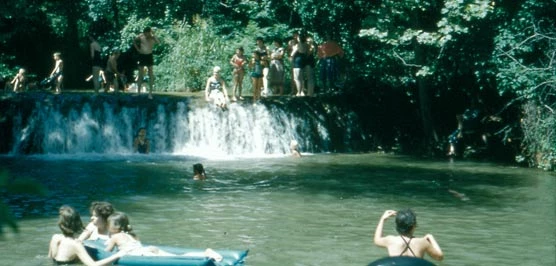
NPS Photo Status of Bacterial Levels for Beach Recreational Use
When bacterial levels at individual swimming beaches are at a level of concern, those particular beaches are posted with the following notice: "Bacterial levels exceed National Park Service standards for beach recreational use. Because of the increased risk of contracting an illness, the National Park Service advises against swimming in the stream until further notice." Why does Chickasaw National Recreation Area test for E. coli?We sample and test water to determine the levels of bacteria that might indicate the presence of disease causing organisms. Elevated readings have been recorded during high use periods, after heavy rainfall events, and during periods of extended drought. Since 2001, we have been posting notices along the creek(s) when elevated readings occur. The water quality monitoring program continues weekly during the summer swimming months and monthly through the winter months, and a standard operating procedure for beach posting is in place. Possible illnessesRecreational activities in bacterially contaminated waters can result in severe infections of the eyes, ears, nose, and throat. Typhoid fever, viral and bacterial gastroenteritis, and Hepatitis A are potentially contracted from contaminated water. Children, pregnant women, and elderly persons are the most at risk. Contact your primary health care provider if you have concerns about swimming in public water.
The map below is provided for location reference. Areas of high bacterial concern are not marked on this map. A written description of the testing locations is located below the map.
Frequently Asked QuestionsWhere are the testing locations?
When can we swim in the creeks and the lake?Water samples are taken weekly during the summer swimming season by a hydrologic technician and then analyzed at the natural resource laboratory here on the park. Test results are completed and posted on the park's website within 24 hours. Bacteria levels may fluctuate from day to day. When collected samples exceed E. coli limits, the public health standard requires that the previous four weeks be averaged with the current readings to monitor long term trends. If the five week average and/or geometric mean is above the action level, the beach is posted with a sign notifying the public of high bacerial levels in the swimming area. When both the five week average and geometric mean fall below the action level, the notices signs are removed. Other visitors are swimming even though a notice sign is posted. Is it safe?Chickasaw National Recreation Area post notices to inform the public and to allow visitors to make their own decisions about how to recreate in the park safely. Notice signBacterial levels exceed National Park Service standards for beach recreational use. Because of the increased risk of contracting an illness, the National Park Service advises against swimming in the stream until further notice. Where are the samples taken and where are the notices posted?In popular swimming areas along Travertine Creek, Rock Creek, and Lake of the Arbuckles. Why does Chickasaw National Recreation Area test for E. coli?We sample and test water to determine the levels of bacteria that might indicate the presence of disease causing organisms. Has the park tested for E. coli before? How long has the park tested for E. coli?Since 2001, we have sampled and tested water in popular swimming areas along Travertine and Rock Creeks to determine the levels of bacteria that might indicate the presence of disease-causing organisms. How often do the elevated levels of E. coli occur?Elevated readings have been recorded during high use periods, after heavy rainfall events, and during periods of extended drought. Since 2001, we have been posting notices along the creek(s) when elevated readings occur. How long is the monitoring period? Do you test year round?The water quality monitoring program continues weekly during the summer swimming months, and monthly during the rest of the year. A standard operating procedure for beach posting is in place. What are the sources of E. coli?Microorganisms, including E. coli bacteria, are found in every part of our environment. E. coli bacteria naturally occur in the gastrointestinal tract of humans and many other warm blooded animals. These bacteria aid in the digestion process and usually cause no harm. However, their presence in a water system is an indicator that other potential disease-causing pathogens may be present. Certain diseased animals may pass along these pathogens in their fecal waste products. A few of the sources of E. coli contamination include: Domestic animal and wildlife waste, sewer overflows, seepage from septic systems, and runoff from surrounding streets and agricultural facilities. In addition, other human influences such as infants entering the water in diapers, or the over crowding of a given swimming area can lead to elevated bacterial levels. Possible illnessesRecreational activities in bacterially contaminated waters can result in severe infections of the eyes, ears, nose, and throat. Typhoid fever, viral and bacterial gastroenteritis, and Hepatitis "A", are potentially contracted from contaminated water. Children, pregnant women, and elderly persons are the most susceptible. Contact your primary health care provider. For more informationContact the Travertine Nature Center (580) 622-7234. An informational letter is available upon request. Please send name and mailing address to Chickasaw National Recreation Area, 901 W. 1st Street, Sulphur, OK 73086. |
Last updated: August 28, 2025
